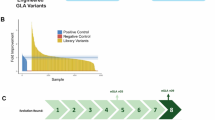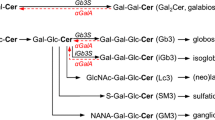Summary
Fabry disease is an X-linked lysosomal storage disorder caused by mutations in the gene encoding α-galactosidase A (α-Gal A), with consequent accumulation of its major glycosphingolipid substrate, globotriaosylceramide (GL-3). Over 500 Fabry mutations have been reported; approximately 60% are missense. The iminosugar 1-deoxygalactonojirimycin (DGJ, migalastat hydrochloride, AT1001) is a pharmacological chaperone that selectively binds α-Gal A, increasing physical stability, lysosomal trafficking, and cellular activity. To identify DGJ-responsive mutant forms of α-Gal A, the effect of DGJ incubation on α-Gal A levels was assessed in cultured lymphoblasts from males with Fabry disease representing 75 different missense mutations, one insertion, and one splice-site mutation. Baseline α-Gal A levels ranged from 0 to 52% of normal. Increases in α-Gal A levels (1.5- to 28-fold) after continuous DGJ incubation for 5 days were seen for 49 different missense mutant forms with varying EC50 values (820 nmol/L to >1 mmol/L). Amino acid substitutions in responsive forms were located throughout both structural domains of the enzyme. Half of the missense mutant forms associated with classic (early-onset) Fabry disease and a majority (90%) associated with later-onset Fabry disease were responsive. In cultured fibroblasts from males with Fabry disease, the responses to DGJ were comparable to those of lymphoblasts with the same mutation. Importantly, elevated GL-3 levels in responsive Fabry fibroblasts were reduced after DGJ incubation, indicating that increased mutant α-Gal A levels can reduce accumulated substrate. These data indicate that DGJ merits further evaluation as a treatment for patients with Fabry disease with various missense mutations.







Similar content being viewed by others
Abbreviations
- DGJ:
-
1-deoxygalactonojirimycin hydrochloride (AT1001: migalastat hydrochloride)
- EC50 :
-
effective concentration 50% (the concentration of DGJ yielding 50% of the maximal effect)
- GalNac:
-
N-acetyl-d-galactosamine
- GL-3:
-
globotriaosylceramide
- GLA :
-
gene encoding α-Gal A
- α-Gal A:
-
α-galactosidase A
- 4-MU:
-
4-methylumbelliferone
- 4-MUG:
-
4-MU-α-d-galactopyranoside
References
Asano N, Ishii S, Kizu H, et al (2000) In vitro inhibition and intracellular enhancement of lysosomal alpha-galactosidase A activity in Fabry lymphoblasts by 1-deoxygalactonojirimycin and its derivatives. Eur J Biochem 267: 4179–4186. doi:10.1046/j.1432-1327.2000.01457.x.
Askari H, Kaneski C, Semino-Mora C, et al (2007) Cellular and tissue localization of globotriaosylceramide in Fabry disease. Virchows Arch 451: 823–834. doi:10.1007/s00428-007-0468-6.
Bekri S, Enica A, Ghafari T, et al (2005) Fabry disease in patients with end-stage renal failure: the potential benefits of screening. Nephron Clin Pract 101: c33–38. doi:10.1159/000085709.
Bishop D, Grabowski G, Desnick R (1981) Fabry disease: An asymptomatic hemizygote with significant residual alpha-galactosidase A activity. Am J Hum Genet 33: 71A.
Brady RO, Gal AE, Bradley RM, Martensson E, Warshaw AL, Laster L (1967) Enzymatic defect in Fabry’s disease: ceramidetrihexosidase deficiency. N Engl J Med 276: 1163–1167.
Branton MH, Schiffmann R, Sabnis SG, et al (2002) Natural history of Fabry renal disease: influence of alpha-galactosidase A activity and genetic mutations on clinical course. Medicine 81: 122–138. doi:10.1097/00005792-200203000-00003.
Chimenti C, Pieroni M, Morgante E, et al (2004) Prevalence of Fabry disease in female patients with late-onset hypertrophic cardiomyopathy. Circulation 110: 1047–1053. doi:10.1161/01.CIR.0000139847.74101.03.
Desnick R, Ioannou Y, Eng C (2001) alpha-Galactosidase A deficiency; Fabry disease. In: Scriver CR, Beaudet AL, Sly WS, Valle D, eds; Childs B, Kinzler KW, Vogelstein B, assoc. eds. The Metabolic and Molecular Bases of Inherited Disease, 8th edn. New York: McGraw-Hill, 3507–3534.
Fan J-Q (2003) A contradictory treatment for lysosomal storage disorders: inhibitors enhance mutant enzyme activity. Trends Pharmacol Sci 24: 355–360. doi:10.1016/S0165-6147(03)00158-5.
Fan J-Q, Ishii S, Asano N, Suzuki Y (1999) Accelerated transport and maturation of lysosomal α-galactosidase A in Fabry lymphoblasts by an enzyme inhibitor. Nature Med 5: 112–115. doi:10.1038/4801.
Garman S (2007) Structure–function relationships in alpha-galactosidase A. Acta Paediatr Suppl 96: 6–16. doi:10.1111/j.1651-2227.2007.00097.x.
Garman SC, Garboczi DN (2004) The molecular defect leading to Fabry disease: structure of human alpha-galactosidase. J Mol Biol 337: 319–335. doi:10.1016/j.jmb.2004.01.035.
Guex N, Peitsch M (1997) SWISS-MODEL and the Swiss-PdbViewer: an environment for comparative protein modeling. Electrophoresis 18: 2714–2723. doi:10.1002/elps.1150181505.
Ioannou YA, Bishop DF, Desnick RJ (1992) Overexpression of human alpha-galactosidase A results in its intracellular aggregation, crystallization in lysosomes, and selective secretion. J Cell Biol 119: 1137–1150. doi:10.1083/jcb.119.5.1137.
Ioannou YA, Zeidner KM, Grace ME, Desnick R (1998) Human alpha-galactosidase A: glycosylation site 3 is essential for enzyme solubility. Biochem J 332: 789–797.
Ishii S, Kase R, Okumiya T, Sakuraba H, Suzuki Y (1996) Aggregation of the inactive form of human alpha-galactosidase in the endoplasmic reticulum. Biochem Biophys Res Commun 220: 812–815. doi:10.1006/bbrc.1996.0486.
Ishii S, Chang HH, Kawasaki K, et al (2007) Mutant alpha-galacatosidase A enzymes identified in Fabry patients with residual enzyme activity: Biochemical characterization and restoration of normal intracellular processing by 1-deoxygalactonojirimycin. Biochem J 406: 285–295. doi:10.1042/BJ20070479.
Ishii S, Chang H, Yoshioka H, et al (2009) Preclinical efficacy and safety of 1-deoxygalactonojirimycin in mice for Fabry disease. J Pharmacol Exp Ther 328(3): 723–731.
Khanna R, Benjamin ER, Soska R, et al (2007) The pharmacological chaperone AT1001 reduces globotriaosylceramide substrate levels in Fabry transgenic mice and increases α-galactosidase. A levels in vitro, in vivo and in healthy volunteers. Abstract 2250/W. Presented at the American Society of Human Genetics Conference, San Diego, October 23–27, 2007.
Kint JA (1970) Fabry’s disease: alpha-galactosidase deficiency. Science 167: 1268–1269. doi:10.1126/science.167.3922.1268.
Kotanko P, Kramar R, Devrnja D, et al (2004) Results of a nationwide screening for Anderson-Fabry disease among dialysis patients. J Am Soc Nephrol 15: 1323–1329. doi:10.1097/01.ASN.0000124671.61963.1E.
Lemansky P, Bishop D, Desnick R, Hasilik A, von Figura K (1987) Synthesis and processing of alpha-galactosidase A in human fibroblasts. Evidence for different mutations in Fabry disease. J Biol Chem 262: 2062–2065.
Matsuzawa F, Aikawa S-I, Doi H, Okumiya T, Sakuraba H (2005) Fabry disease: correlation between structural changes in α-galactosidase, and clinical and biochemical phenotypes. Hum Genet 117: 317–328. doi:10.1007/s00439-005-1300-5.
Mayes JS, Scheerer JB, Sifers RN, Donaldson ML (1981) Differential assay for lysosomal alpha-galactosidases in human tissues and its application to Fabry’s disease. Clin Chim Acta 112: 247–251. doi:10.1016/0009-8981(81)90384-3.
Monserrat L, Gimeno-Blanes J, Marin F, et al (2007) Prevalence of Fabry disease in a cohort of 508 untrelated patients with hypertrophic cardiomyopathy. J Am Coll Cardiol 50: 2399–2403. doi:10.1016/j.jacc.2007.06.062.
Nakao S, Takenaka T, Maeda M, et al (1995) An atypical variant of Fabry’s disease in men with left ventricular hypertrophy. N Engl J Med 333: 288–293. doi:10.1056/NEJM199508033330504.
Nakao S, Kodama C, Takenaka T, et al (2003) Fabry disease: detection of undiagnosed hemodialysis patients and identification of a ‘renal variant’ phenotype. Kidney Int 64: 801–807. doi:10.1046/j.1523-1755.2003.00160.x.
Neitzel H (1986) A routine method for the establishment of permanent growing lymphoblastoid cell lines. Hum Genet 73: 320–326. doi:10.1007/BF00279094.
Okumiya T, Ishii S, Takenaka T, et al (1995) Galactose stabilizes various missense mutants of alpha-galactosidase in Fabry disease. Biochem Biophys Res Commun 214: 1219–1224. doi:10.1006/bbrc.1995.2416.
Rolfs A, Bottcher T, Zschiesche M, et al (2005) Prevalence of Fabry disease in patients with cryptogenic stroke: a prospective study. Lancet 366: 1794–1796. doi:10.1016/S0140-6736(05)67635-0.
Sachdev B, Takenaka T, Teraguchi H, et al (2002) Prevalence of Anderson-Fabry disease in male patients with late onset hypertrophic cardiomyopathy. Circulation 105: 1407–1411. doi:10.1161/01.CIR.0000012626.81324.38.
Schiffmann R, Germain DP, Castelli J, et al (2008) Phase 2 clinical trials of the pharmacological chaperone AT1001 for the treatment of Fabry disease. Abstract 768/T. Presented at the American Society of Human Genetics Conference, Philadelphia, November 11–15, 2008.
Shabbeer J, Yasuda M, Luca E, Desnick R (2002) Fabry disease: 45 novel mutations in the alpha-galactosidase A gene causing the classical phenotype. Mol Genet Metab 76: 23–30. doi:10.1016/S1096-7192(02)00012-4.
Shabbeer J, Yasuda M, Benson S, Desnick R (2006) Fabry disease: Identification of 50 novel α-galactosidase A mutations causing the classic phenotype and three-dimensional structural analysis of 29 missense mutations. Hum Genomics 2: 297–309.
Shin S-H, Murray G, Kluepfel-Stahl S, et al (2007) Screening for pharmacological chaperones in Fabry disease. Biochem Biophys Res Commun 359: 168–173. doi:10.1016/j.bbrc.2007.05.082.
Shin S-H, Kluepfel-Stahl S, Cooney A, et al (2008) Prediction of response of mutated alpha-galactosidase A to a pharmacological chaperone. Pharmacogenet Genomics 18: 773–780. doi:10.1097/FPC.0b013e32830500f4.
Spada M, Pagliardini S, Yasuda M, et al (2006) High incidence of later-onset Fabry disease revealed by newborn screening. Am J Hum Genet 79: 31–40. doi:10.1086/504601.
Stenson PD, Ball EV, Mort M, et al (2003) Human gene mutation database (HGMD): 2003 update. Hum Mutat 21: 577–581. doi:10.1002/humu.10212.
von Scheidt W, Eng C, Fitzmaurice T, et al (1991) An atypical variant of Fabry’s disease with manifestations confined to the myocardium. N Engl J Med 324: 395–399.
Yam GH, Zuber C, Roth J (2005) A synthetic chaperone corrects the trafficking defect and disease phenotype in a protein misfolding disorder. FASEB J 19: 12–18. doi:10.1096/fj.04-2375com.
Yam GH, Bosshard N, Zuber C, Steinmann B, Roth J (2006) Pharmacological chaperone corrects lysosomal storage in Fabry disease caused by trafficking-incompetent variants. Am J Physiol Cell Physiol 290: C1076–1082. doi:10.1152/ajpcell.00426.2005.
Author information
Authors and Affiliations
Corresponding author
Additional information
Communicating editor: Gregory Pastores
Competing interests: All authors are shareholders, current or former employees of Amicus Therapeutics.
References to electronic databases: Fabry disease: OMIM 310500. α-Galactosidase A: EC 3.2.1.22. GLA: GenBank gDNA: X14448.1.
Rights and permissions
About this article
Cite this article
Benjamin, E.R., Flanagan, J.J., Schilling, A. et al. The pharmacological chaperone 1-deoxygalactonojirimycin increases α-galactosidase A levels in Fabry patient cell lines. J Inherit Metab Dis 32, 424–440 (2009). https://doi.org/10.1007/s10545-009-1077-0
Received:
Revised:
Accepted:
Published:
Issue Date:
DOI: https://doi.org/10.1007/s10545-009-1077-0




